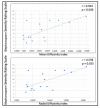Cortico-Subcortical White Matter Bundle Changes in Cervical Dystonia and Blepharospasm
- PMID: 36979732
- PMCID: PMC10044819
- DOI: 10.3390/biomedicines11030753
Cortico-Subcortical White Matter Bundle Changes in Cervical Dystonia and Blepharospasm
Abstract
Dystonia is thought to be a network disorder due to abnormalities in the basal ganglia-thalamo-cortical circuit. We aimed to investigate the white matter (WM) microstructural damage of bundles connecting pre-defined subcortical and cortical regions in cervical dystonia (CD) and blepharospasm (BSP). Thirty-five patients (17 with CD and 18 with BSP) and 17 healthy subjects underwent MRI, including diffusion tensor imaging (DTI). Probabilistic tractography (BedpostX) was performed to reconstruct WM tracts connecting the globus pallidus, putamen and thalamus with the primary motor, primary sensory and supplementary motor cortices. WM tract integrity was evaluated by deriving their DTI metrics. Significant differences in mean, radial and axial diffusivity between CD and HS and between BSP and HS were found in the majority of the reconstructed WM tracts, while no differences were found between the two groups of patients. The observation of abnormalities in DTI metrics of specific WM tracts suggests a diffuse and extensive loss of WM integrity as a common feature of CD and BSP, aligning with the increasing evidence of microstructural damage of several brain regions belonging to specific circuits, such as the basal ganglia-thalamo-cortical circuit, which likely reflects a common pathophysiological mechanism of focal dystonia.
Keywords: basal ganglia-thalamo-cortical circuit; blepharospasm; cervical dystonia; diffusion tensor imaging; focal dystonia; probabilistic tractography; structural MRI; white matter.
Conflict of interest statement
The authors declare no conflict of interest.
Figures






References
-
- Giannì C., Pasqua G., Ferrazzano G., Tommasin S., De Bartolo M.I., Petsas N., Belvisi D., Conte A., Berardelli A., Pantano P. Focal Dystonia: Functional Connectivity Changes in Cerebellar-Basal Ganglia-Cortical Circuit and Preserved Global Functional Architecture. Neurology. 2022;98:e1499–e1509. doi: 10.1212/WNL.0000000000200022. - DOI - PubMed
LinkOut - more resources
Full Text Sources

